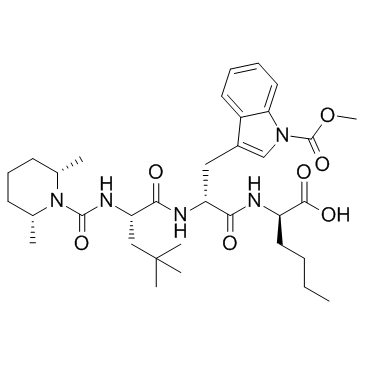| In Vitro |
BQ-788 potently and competitively inhibits 125I-labeled ET-1 binding to ETB receptors in human Girrardi heart cells (hGH) with an IC50 of 1.2 nM, but only poorly inhibits the binding to ETA receptors in human neuro-blastoma cell line SK-N-MC cells (IC50, 1300 nM). BQ-788 shows no agonistic activity up to 10 μM and competitively inhibits thevasoconstriction induced by an ETB-selective agonist (pA2, 8.4). BQ-788 also inhibits several bioactivities of ET-1, such as bronchoconstriction, cell proliferation, and clearance of perfused ET-1[1].
|
| In Vivo |
BQ-788 (3 mg/kg/h, i.v.) completely inhibits a pharmacological dose of ET-1- or sarafotoxin6c (0.5 nmol/kg, i.v.)-induced ETB receptor-mediated depressor, but not pressor responses in conscious rats. Furthermore, BQ-788 markedly increases the plasma concentration of ET-1, which is considered an index of potential ETB receptor blockade in vivo. In Dahl salt-sensitive hypertensive (DS) rats, BQ-788 (3 mg/kg/h, i.v.) increases blood pressure by about 20 mm Hg. It is reported that BQ-788 also inhibits ET-1-induced bronchoconstriction, tumor growth and lipopolysaccharide-induced organfailure[1]. BQ 788 (3 mg/kg) results in an eightfold leftward shift in the ET-1 dose-response curve, suggesting a significant involvement of ETB dilator receptors[2]. Mice are treated with 30 nmol BQ-788 by intraplantar, reduce mechanical hyperalgesia (47% and 42%), thermal hyperalgesia (68% and 76%), oedema (50% and 30%); myeloperoxidase activity (64% and 32%), and overt-pain like behaviours. Additionally, intraplantar treatment with clazosentan or BQ-788 decreases spinal (45% and 41%) and peripheral (47% and 47%) superoxide anion production as well as spinal (47% and 47%) and peripheral (33% and 54%) lipid peroxidation, respectively[3].
|


